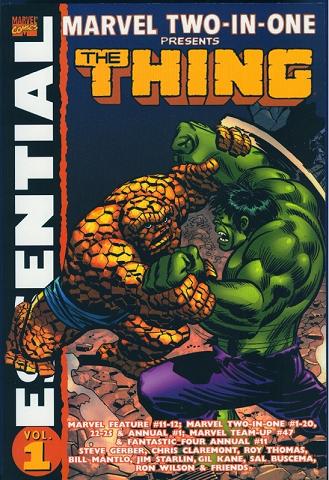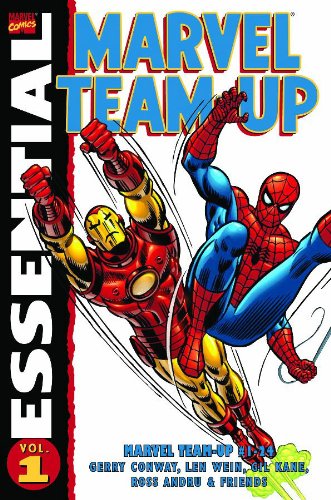
Essential Marvel Two-in-One Vol. 1
Steve Gerber, Bill Mantlo, Sal Buscema and friends
Reprints: Marvel Feature #11-12, Marvel Two in One #1-20, 22-25 and more (January 1974 – March 1977)
Get this for: Seventies superheroics — three stars
We’ve already had a volume of Essential Marvel Team-Up, so now it’s time for that other classic teamup title: Marvel Two-in-One. Whereas the former had Spider-Man as its main character, Marvel Two-in-One had The Thing, Marvel’s second most sympathic character. It may seem a strange choice at first to have him as the lead — why not Mr Fantastic or the Torch instead — but it works. The Thing has many of the same qualities as Spider-Man: an everyman, powerful but kind, with problems all his power can’t solve and somebody who you can imagine having a beer with. What also helps is that you can put him in almost every situation and have it make sense, as this volume makes clear; something you can’t do with e.g. Daredevil.
Essential Marvel Two-in-One Vol. 1 contains the last two issues of Marvel Feature, #11-12, the first twentyfive issues (excluding #21) of Marvel Two-in-One plus the first annual, as well as crossover issues with Marvel Team-Up (#47) and Fantastic Four (Annual #11). Issue 21 was excluded because it featured Doc Savage, who Marvel no longer has the rights to. Marvel Feature was a failed tryout title that had also featured an attempt to revive Antman amongst others and it’s clear that this was used to try the waters so to speak.
The first nine issues of Marvel Two-in-One were written by Steve Gerber, picking up one loose thread from his Man-Thing stories: Wundarr, the Superman analog with the brain of a two year old turns up again and Thing becomes his uncle Benji, though he isn’t too pleased about it. Gerber also has teamups with some of his other characters: first the Guardians of the Galaxy, then Doc Strange and the Valkyrie from The Defenders. After Gerber left, Bill Mantlo took over the writing duties, with some fill-ins from people like Chris Claremont, Roger Slifer and Roy Thomas, the latter doing a crossover with his WWII teams Invaders and Liberty Legion. None of the writing, not even Gerber’s is particularly great, with most of the stories being simple “Heroes meet, misunderstand each other, spar a bit, then tackle the real villain together”. The real interest lies squarely with the featured heroes and villains.
Those featured here are a nice mixture of the well known and the obscure. Apart from the ones mentioned above, there’s Thor, Iron Man, Daredevil, Captain America and the Fantastic Four, but also Tigra, Scarecrow, the Golem, the Son of Satan and Morbius to name just a few of the more obscure. For some of these teamups you quickly suspect that they’re mostly done to close up some dangling plotlines from their own just cancelled series. Scarecrow is one of those, a horror hero that had had two previous appearances and had been intended for his own series, which never got off the ground; Marvel Two-in-One #18 concludes his story. As to the villains featured, few are that interesting: also rans like Miracle Man or the Puppet Master or the Basilik, as well as some new ones cooked up especially for the series like Sword of Judgement.
The art for the most part is not … the best … Marvel featured in that period. It’s mostly uninspiring but dependable artists like Herb Trimpe, Bob Brown, Ron Wilson and Sal Buscema, who are all capable of better work than is on display here. As is Gil Kane, normally a welcome sight in a volume like this, but his work in issue one and two is no more than adequate. The art does fit the stories, that’s the best you can say of it.
Marvel Two-in-One would get better much later on, especially when Mark Gruenwald was writing it and George Perez handled the art, but that’s a long way away yet from this volume. It is the sort of comics I grew up with, but for those who didn’t, you’re not missing that much here.
